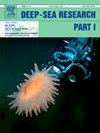Enhanced diapycnal mixing of a subsurface anticyclonic eddy pair in the northeastern South China Sea
IF 2.1
3区 地球科学
Q2 OCEANOGRAPHY
Deep-Sea Research Part I-Oceanographic Research Papers
Pub Date : 2025-04-10
DOI:10.1016/j.dsr.2025.104502
引用次数: 0
Abstract
Mesoscale eddies, which play a vital role in transporting substances and regulating marine ecosystems, are particularly active and energetic in the northern South China Sea (SCS). However, their fine-scale structures and diapycnal diffusivity inside and outside eddies remain poorly understood. In this study, a pair of subsurface anticyclonic eddies (A1 and A2) in the northern SCS was investigated using 7 seismic reflection transects acquired in April 2009. The anticyclonic eddies consist of two closely adjacent, bowl-shaped subsurface structures, each approximately 70 km in diameter and extending to a depth of 700 m. The transition zone between the eddies is approximately 10 km wide and 500 m deep. These two eddies merge together in the upper water above 500 m. The average diffusivity across the eddy is ∼7.7 × 10−5 m2 s−1 quantified from seismic data. Within the eddy centers (A1 and A2), the diffusivities are relatively low, approximately 2.4 and 3.9 × 10−5 m2 s−1, but increase to more than 4.9 × 10−5 m2 s−1 in the eddy transition zone. Diffusivities in the frontal zone between the eddy and the Kuroshio reach a maximum of 13.9 × 10−5 m2 s−1. We suggest that the shear instability occurring near the frontal region is the primary energy source for turbulent mixing in this region. These findings provide valuable insights into the turbulent mixing associated with irregular eddies and contribute to a more comprehensive understanding of the interactions between eddies and the ocean.
南海东北部一对次表层反气旋涡的近岸混合增强
中尺度涡旋在物质运输和海洋生态系统调节中起着至关重要的作用,在南海北部尤为活跃。然而,它们的精细结构和内外涡旋的内旋扩散率仍然知之甚少。本研究利用2009年4月采集的7个地震反射样带,对南海北部的一对地下反气旋涡旋A1和A2进行了研究。反气旋涡旋由两个紧密相连的碗状地下结构组成,每个直径约70公里,延伸至700米深。涡旋之间的过渡区宽约10公里,深约500米。这两个漩涡在500米以上的上层水域汇合在一起。通过地震资料量化的平均涡旋扩散系数为~ 7.7 × 10−5 m2 s−1。在涡旋中心(A1和A2)内,扩散系数相对较低,约为2.4和3.9 × 10−5 m2 s−1,但在涡旋过渡区增加到4.9 × 10−5 m2 s−1以上。在涡旋和黑潮之间的锋面区扩散系数最大,达到13.9 × 10−5 m2 s−1。我们认为锋面附近发生的剪切不稳定是该区域湍流混合的主要能量来源。这些发现为与不规则漩涡相关的湍流混合提供了有价值的见解,并有助于更全面地了解漩涡与海洋之间的相互作用。
本文章由计算机程序翻译,如有差异,请以英文原文为准。
求助全文
约1分钟内获得全文
求助全文
来源期刊
CiteScore
4.60
自引率
4.20%
发文量
144
审稿时长
18.3 weeks
期刊介绍:
Deep-Sea Research Part I: Oceanographic Research Papers is devoted to the publication of the results of original scientific research, including theoretical work of evident oceanographic applicability; and the solution of instrumental or methodological problems with evidence of successful use. The journal is distinguished by its interdisciplinary nature and its breadth, covering the geological, physical, chemical and biological aspects of the ocean and its boundaries with the sea floor and the atmosphere. In addition to regular "Research Papers" and "Instruments and Methods" papers, briefer communications may be published as "Notes". Supplemental matter, such as extensive data tables or graphs and multimedia content, may be published as electronic appendices.

 求助内容:
求助内容: 应助结果提醒方式:
应助结果提醒方式:


